During my time in Middle Tennessee, I visited three different historical sites that were historical because of their role in one of the fiercest battles of the American Civil War. The Battle of Spring Hill and the Battle of Franklin were part of a series of battles between September 18 and December 27, 1864 called the Franklin-Nashville Campaign, though more frequently called Hood’s Tennessee Campaign. Even though the Civil War would go on for another six months after the Battle at Franklin, it was the last great battle of the war. Officially, the Civil War ended in May 1865.
You might wonder why I visited three places just to hear the same story three times about the same battle. The obvious reason is that I was interested in the buildings I was touring. But you might be surprised to learn that I actually enjoyed hearing the story three times. The battle was big and complex (at least for my brain) and there were so many players that hearing it three times helped me to get a firm picture what happened on November 29 and 30, 1864.
Plus, each time I heard it, there was a slightly different bent to the story because I was learning about the battle from the perspective of each house and the people living there at the time.
Because there is so much to share, I broke my visit to these historical sites into two posts. This post includes the history of both battles and my visit to one of the homes. Next week, I’ll finish with my visit to the other two homes.
The Stage
This and the next post are about my visits to Rippavilla Mansion, Carter House and Carnton Planation. But to truly appreciate what I saw and experienced, you have to picture the scene. So, as succinctly as possible, let me set the stage.
Almost from the beginning of the war, the Union/North occupied Nashville. The South’s Confederate Army of Tennessee under the leadership of John Bell Hood came up from Atlanta hoping to lure William T Sherman and his men into battle by threatening to disrupt supply lines. Sherman pursued Hood briefly, then turned back for the March to the Sea. Sherman left George H. Thomas to deal with the Hood threat.
Thomas was to meet up with another cavalry led by John Schofield. Hood’s plan was to prevent them from converging by intercepting Schofield at Spring Hill. Spring Hill is 13 miles south of Franklin and the Battle at Spring Hill took place the day prior to the Battle of Franklin.
The Battle at Spring Hill saw less than 850 causalities. Through a series of miscommunications and poorly coordinated Confederate attacks, Schofield and his men got by Hood and made their way to Franklin.
Battle of Franklin
So, after Schofield’s men sneaked passed Hood and his men during the night, they arrived in Franklin at dawn on November 30, 1864. By noon, they were set up in a defensive position. At 2 p.m. the orders were issued that if all remained quiet, they would withdraw and head to Nashville (still trying to converge with Thomas and his men) at 6 p.m.
Also, around dawn, a Federal (Union/North) Brigadier General commandeered Carter House and set up his headquarters in the parlor. The third thing that happened at dawn was that Hood awoke down in Spring Hill only to realize what happened while he slept. He hurriedly marched his troops toward Franklin. They arrived around 1 p.m.
At 2 p.m., believing it was his last chance to destroy Schofield’s army, Hood ordered his men to launch a frontal attack at 4 p.m.
At 4 p.m. Hood’s Confederate Army of Tennessee, 20,000 men, marched toward the Union line. It took them about 20 minutes to get within firing range of the similarly numbered men led by Schofield.
A few minutes after 5 p.m. it was dark.
This was before flashlights or night vision goggles. This meant firing guns in the dark and lot of hand-to-hand combat. It was brutal and savage. Men, years later, would say that battle was unlike any other they’d fought. One soldier simply said, “It was as if the devil had full possession of the earth.” (use quote box)
The battle lasted barely five hours. At the end of those five hours, 10,000 causalities (killed and wounded) lay on the battlefield. Or, one every two seconds. They were the bloodiest hours of the entire Civil War. In a time before rapid-fire artillery! To put that into perspective, in five hours there were more American causalities than in the first 24 hours of World War II’s Invasion of Normandy (D-Day) which was the largest amphibian assault in history. Three-quarters of the causalities were Confederate.
Around midnight, the Union army withdrew from the gruesome battlefield to march to Nashville where they converged with Thomas in Nashville. They then fought what was left of Hood’s now-demoralized, near starving troops.
After, Hood retreated to Mississippi with less than 40% of the number of troops he started with. He soon after resigned his commission (although in some places I saw said he was relieved of his commission). For intents and purposes, the Confederate Army of Tennessee ceased to exist after the Franklin-Nashville Campaign.
Rippavilla in Spring Hill
Rippavilla Mansion begins as a funny story. A young man, Nathaniel Frances Cheairs IV, tells his father the woman he intends to marry is a neighboring brick-maker’s daughter, Susan Peters McKissack. His father objects. Nathaniel III’s objection? Her name. You see, all previous Nathaniel Cheairs married women named Sarah. Not Susan.
Nathaniel offered his son $5,000 in gold if he would find a Sarah to marry. Nathaniel IV refused. Then Susan’s father stepped in. As a successful man himself of the only local brickyard in the area, he offered the couple all the bricks and slave labor they would need to build a house once they were married.
Finally, Nathaniel III consented to the marriage. He even gifted the newlyweds the $5,000 in gold for their 1841 wedding.
In 1852, construction for their mansion began. I’m not sure why the 11-year gap. It took three years to complete. The family lived in it six years before the Civil War broke out.
The Battle of Springhill, basically, took place in Rippvilla’s backyard. Some of the battlefield remains next to the mansion and you can walk the grounds. The highway you drive in on is the road that Schoefield’s men marched to escape Hood.
The other things that remains (you have to drive about a mile from the house to see it) are two slave cabins. One is in pretty good condition but the other is crumbling and giving way to time. Drive a bit farther and you’ll come to two cemeteries next to each other. One for the family (as pictured in the feature image of post) with a nice rock fence and large ornate headstones in a line. The slave cemetery is enclosed with a wooden fence and haphazardly laid out square markers. Not sure if they didn’t bury deceased slaves in a rows or whether what I saw was a product of time. Even most of the family’s headstones were illegible and uneven in the earth.
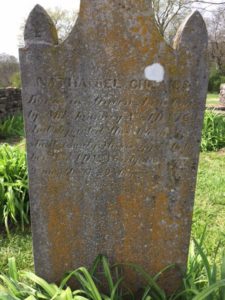
I think this is Nathaniel IV’s grandfather, Nathaniel III’s father. He, too, was a Nathaniel. The only thing I could make out was 1764 and I think it’s a birth year.
All of the furniture in Rippavilla is pre-1865. One music box (photography wasn’t permitted on the tour) appraised at $40,000. What is particularly impressive is that 80% of what’s in the mansion is from the family. I would not have known this was impressive six months ago. But now that I’ve toured many old homes I know it is. Most of the old mansions get period (or near-period) pieces to represent what the place might have looked like but to have so much of the actual furniture of the family’s is pretty great.
Rippavilla was in a state of disrepair when General Motors moved one of its plants to Spring Hill. Rather than hiring all local people, however, many of the Detroit employees moved to Spring Hill. The townspeople were none too happy about that. As a gesture of goodwill, GM purchased Rippavilla (which is just across the highway from GM), donated it to the city along with $1 million to bring it back to life. I’m sure glad they did.
My favorite tidbit I learned on the tour? Have you wondered about the unique name? Nathaniel IV was a bit of a perfectionist. Three separate times, when the house was about 40% complete he would think a wall wasn’t straight or the mortar wasn’t setting up correctly. He had it ripped down and the slaves began again. People started calling is Rippavilla and the name stuck.
Admission for the Rippavilla tour is $12. Be sure to come back next week to read about the Carter House and—my favorite—the Carnton Plantation.


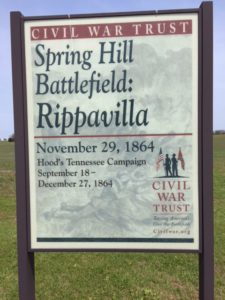
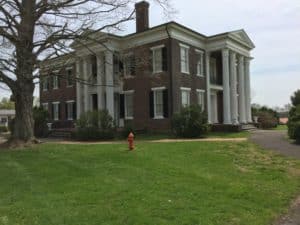
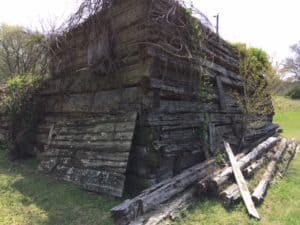
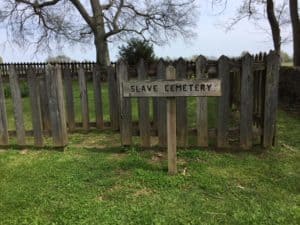
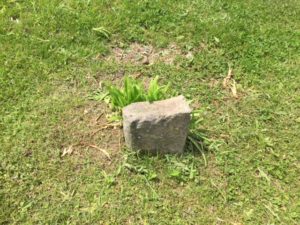



I loved meeting you and having lunch! Next time you are passing through, please let me know! Any friend of my Betsy’s is a friend of mine! Safe travels. And keep posting ! My Monday’s are like a good novel, can’t wait for the next chapter!????
Thank you Kim. It was great meeting and spending time with you.
Love the history but not all the lives lost. I too look forward to the next chapter on Monday nights. Have a great week. Love, Marie
I too have gotten into history in my retirement. I love it! Some in my book club think I’m boring but there is so much to learn. I am happy for you with your new discoveries! I’ve become a history nut also but can only read about it in books… You get to experience it!
History is so rich, especially if we can see the thread to our own time and lives. Glad you are enjoying the history posts.